MGMT-6100: IPD Technical Report and Project Feasibility Assessment
VerifiedAdded on 2023/05/30
|23
|5005
|316
Report
AI Summary
This technical report examines Integrated Project Delivery (IPD) within the Architecture, Engineering, and Construction (AEC) sector. It begins by analyzing project management theories and practices, focusing on IPD's role in the construction industry. The report investigates IPD's application, strengths, and weaknesses, including its adaptation in Canada with examples. It also explores the relationship between Building Information Modeling (BIM) and IPD for project delivery. The second part of the report presents a structured technical report focusing on the adoption, implementation, and deployment of an Integrated Project Delivery system for a proposed project. This includes a SWOT analysis, feasibility assessment, and an IPD plan. The report also covers procurement options, risk assessment, and provides conclusions and recommendations for the project owner. The project schedule is developed using Microsoft Project Management software.

Running head: INTEGRATED PRACTICE FOR THE AEC SECTOR
Integrated Project Delivery
TECHNICAL REPORT and PROJECT FEASIBILITY ASSESSMENT
Name of the Student
Name of the University
Author note
Integrated Project Delivery
TECHNICAL REPORT and PROJECT FEASIBILITY ASSESSMENT
Name of the Student
Name of the University
Author note
Paraphrase This Document
Need a fresh take? Get an instant paraphrase of this document with our AI Paraphraser
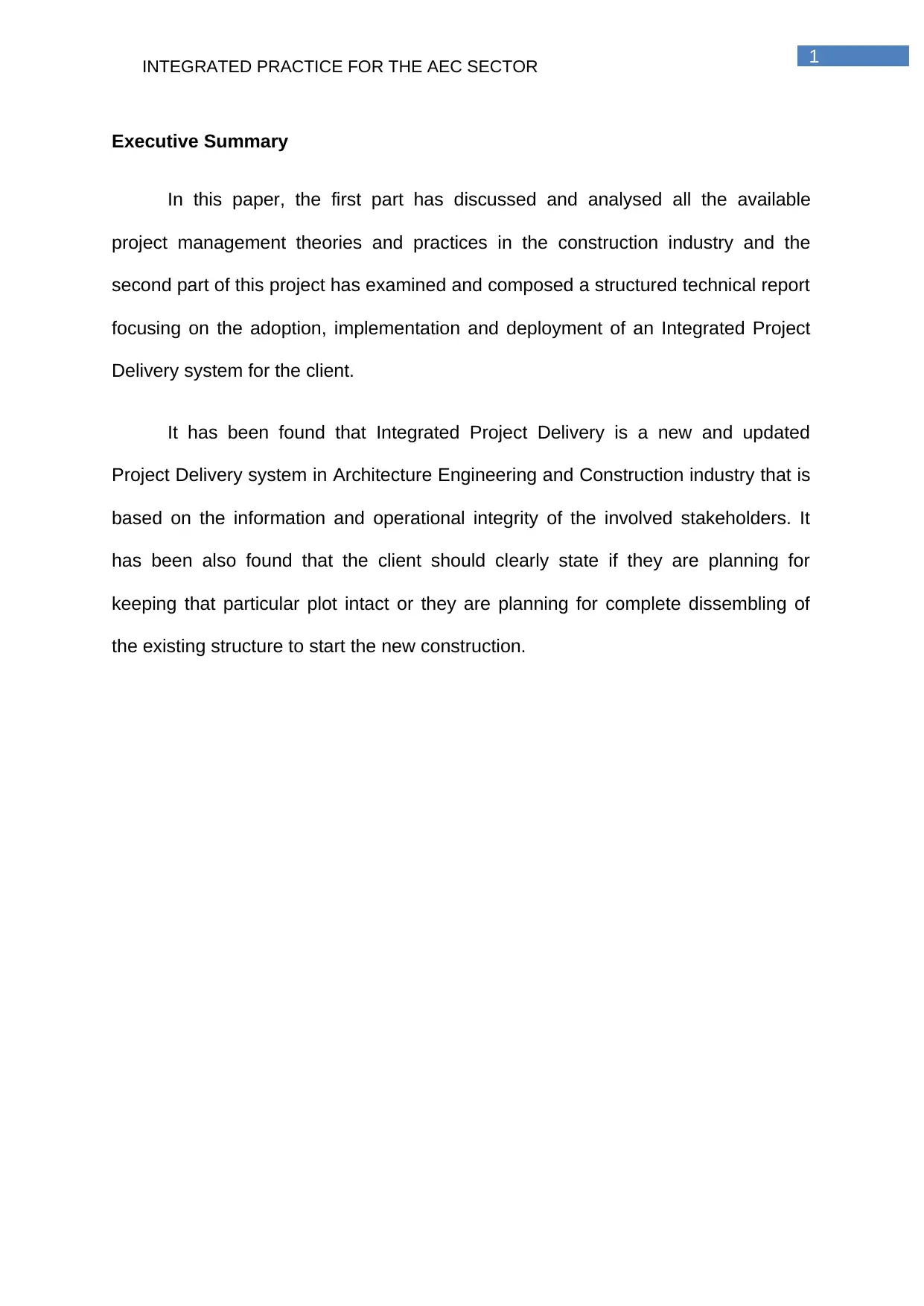
1
INTEGRATED PRACTICE FOR THE AEC SECTOR
Executive Summary
In this paper, the first part has discussed and analysed all the available
project management theories and practices in the construction industry and the
second part of this project has examined and composed a structured technical report
focusing on the adoption, implementation and deployment of an Integrated Project
Delivery system for the client.
It has been found that Integrated Project Delivery is a new and updated
Project Delivery system in Architecture Engineering and Construction industry that is
based on the information and operational integrity of the involved stakeholders. It
has been also found that the client should clearly state if they are planning for
keeping that particular plot intact or they are planning for complete dissembling of
the existing structure to start the new construction.
INTEGRATED PRACTICE FOR THE AEC SECTOR
Executive Summary
In this paper, the first part has discussed and analysed all the available
project management theories and practices in the construction industry and the
second part of this project has examined and composed a structured technical report
focusing on the adoption, implementation and deployment of an Integrated Project
Delivery system for the client.
It has been found that Integrated Project Delivery is a new and updated
Project Delivery system in Architecture Engineering and Construction industry that is
based on the information and operational integrity of the involved stakeholders. It
has been also found that the client should clearly state if they are planning for
keeping that particular plot intact or they are planning for complete dissembling of
the existing structure to start the new construction.

2
INTEGRATED PRACTICE FOR THE AEC SECTOR
Table of Content
Introduction...................................................................................................................4
Part B1:.........................................................................................................................5
Integrated project delivery Relation with integrated practice....................................5
Strength and Weakness of IPD in AEC participants.................................................6
IPD adaptation in Canada and Example projects.....................................................7
Relationship between BIM and IPD for project delivery...........................................8
Assessment of the limitations to applying IPD in Construction project....................9
Part B2:.........................................................................................................................9
Procurement options for client..................................................................................9
Strength and Weakness of methods.......................................................................10
Risk Assessment.....................................................................................................11
Summary.................................................................................................................13
SWOT analysis of the project.................................................................................13
Feasibility Assessment...........................................................................................14
IPD plan for Proposed project.................................................................................15
Conclusion and recommendation for owner:..............................................................17
Reference:..................................................................................................................19
Appendices:................................................................................................................22
Appendix 1: Project Schedule.................................................................................22
INTEGRATED PRACTICE FOR THE AEC SECTOR
Table of Content
Introduction...................................................................................................................4
Part B1:.........................................................................................................................5
Integrated project delivery Relation with integrated practice....................................5
Strength and Weakness of IPD in AEC participants.................................................6
IPD adaptation in Canada and Example projects.....................................................7
Relationship between BIM and IPD for project delivery...........................................8
Assessment of the limitations to applying IPD in Construction project....................9
Part B2:.........................................................................................................................9
Procurement options for client..................................................................................9
Strength and Weakness of methods.......................................................................10
Risk Assessment.....................................................................................................11
Summary.................................................................................................................13
SWOT analysis of the project.................................................................................13
Feasibility Assessment...........................................................................................14
IPD plan for Proposed project.................................................................................15
Conclusion and recommendation for owner:..............................................................17
Reference:..................................................................................................................19
Appendices:................................................................................................................22
Appendix 1: Project Schedule.................................................................................22
⊘ This is a preview!⊘
Do you want full access?
Subscribe today to unlock all pages.

Trusted by 1+ million students worldwide

3
INTEGRATED PRACTICE FOR THE AEC SECTOR
Introduction
In Architecture, Engineering and Construction project thee major factors are
essential that includes the delivery management, procurement management and
contractual policies. This paper will focus on the delivery management as well as the
procurement management system while comparing all the available methods and
their utility (Walker, 2015). The major stakeholders in a construction project are the
owner, Architect, project leaders, Engineers, Contractors, Vendors and end user.
The responsibilities of all these stakeholders in a constructional project will be
analysed supported b different project development and implementation theories.
The paper has two deeply interconnected parts. The purpose of the first part
of this paper is to discuss and analyse all the available project management theories
and practices in the construction industry. In this part the application of IPD in AEC
industry will be critically analysed. The adaptation of this new project delivery policy
in Canadian construction business will be critically assessed with practical examples.
The purpose of the second part of this project is to research and compose a
structured technical report focusing on the adoption, implementation and deployment
of an Integrated Project Delivery system for the client for a “proposed” project. In this
part the SWOT analysis and the feasibility analysis of the project proposed by the
client will be analysed. The project schedule for this proposed construction project
will be developed through Microsoft Project Management software and will be
attached with this document.
INTEGRATED PRACTICE FOR THE AEC SECTOR
Introduction
In Architecture, Engineering and Construction project thee major factors are
essential that includes the delivery management, procurement management and
contractual policies. This paper will focus on the delivery management as well as the
procurement management system while comparing all the available methods and
their utility (Walker, 2015). The major stakeholders in a construction project are the
owner, Architect, project leaders, Engineers, Contractors, Vendors and end user.
The responsibilities of all these stakeholders in a constructional project will be
analysed supported b different project development and implementation theories.
The paper has two deeply interconnected parts. The purpose of the first part
of this paper is to discuss and analyse all the available project management theories
and practices in the construction industry. In this part the application of IPD in AEC
industry will be critically analysed. The adaptation of this new project delivery policy
in Canadian construction business will be critically assessed with practical examples.
The purpose of the second part of this project is to research and compose a
structured technical report focusing on the adoption, implementation and deployment
of an Integrated Project Delivery system for the client for a “proposed” project. In this
part the SWOT analysis and the feasibility analysis of the project proposed by the
client will be analysed. The project schedule for this proposed construction project
will be developed through Microsoft Project Management software and will be
attached with this document.
Paraphrase This Document
Need a fresh take? Get an instant paraphrase of this document with our AI Paraphraser
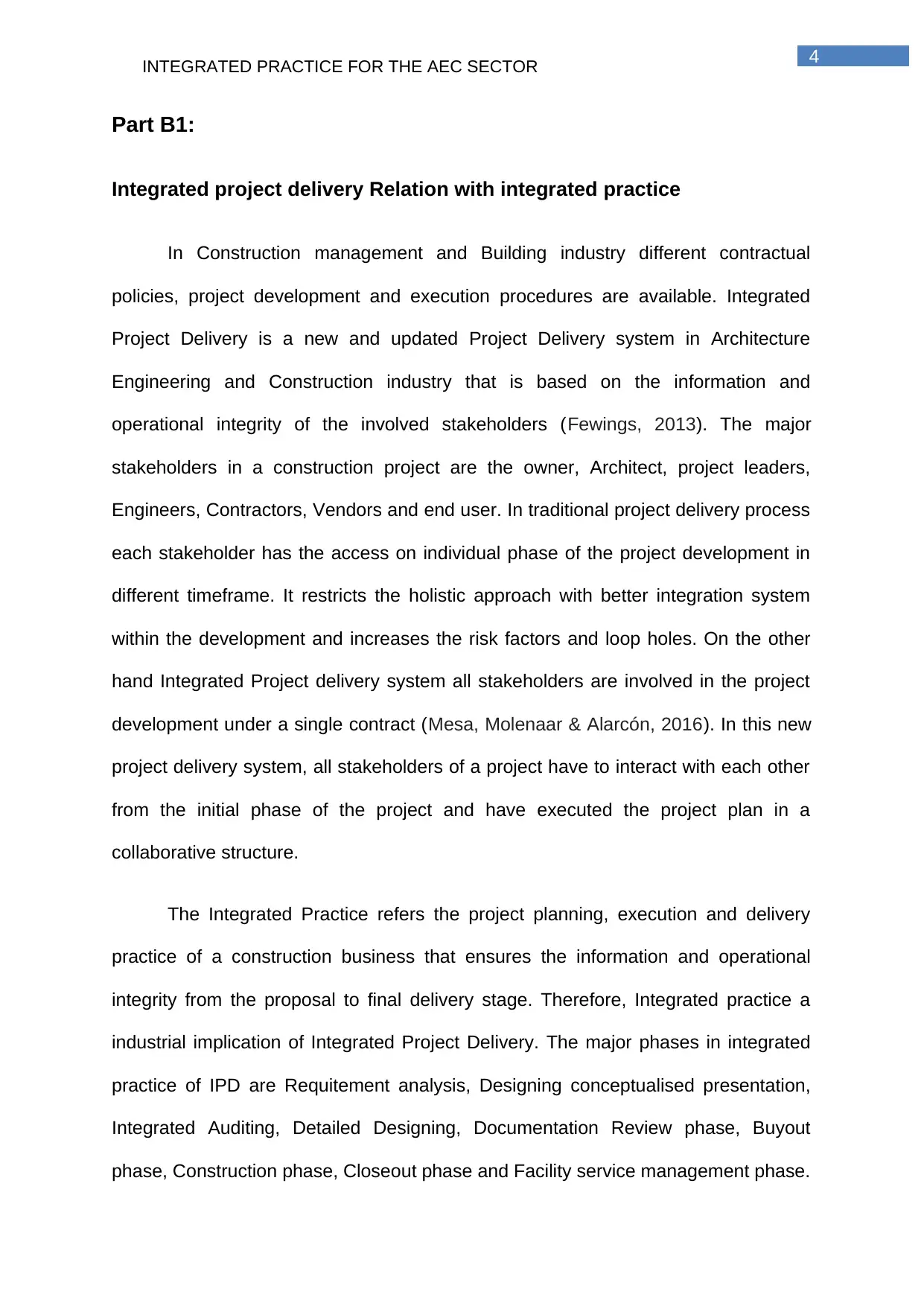
4
INTEGRATED PRACTICE FOR THE AEC SECTOR
Part B1:
Integrated project delivery Relation with integrated practice
In Construction management and Building industry different contractual
policies, project development and execution procedures are available. Integrated
Project Delivery is a new and updated Project Delivery system in Architecture
Engineering and Construction industry that is based on the information and
operational integrity of the involved stakeholders (Fewings, 2013). The major
stakeholders in a construction project are the owner, Architect, project leaders,
Engineers, Contractors, Vendors and end user. In traditional project delivery process
each stakeholder has the access on individual phase of the project development in
different timeframe. It restricts the holistic approach with better integration system
within the development and increases the risk factors and loop holes. On the other
hand Integrated Project delivery system all stakeholders are involved in the project
development under a single contract (Mesa, Molenaar & Alarcón, 2016). In this new
project delivery system, all stakeholders of a project have to interact with each other
from the initial phase of the project and have executed the project plan in a
collaborative structure.
The Integrated Practice refers the project planning, execution and delivery
practice of a construction business that ensures the information and operational
integrity from the proposal to final delivery stage. Therefore, Integrated practice a
industrial implication of Integrated Project Delivery. The major phases in integrated
practice of IPD are Requitement analysis, Designing conceptualised presentation,
Integrated Auditing, Detailed Designing, Documentation Review phase, Buyout
phase, Construction phase, Closeout phase and Facility service management phase.
INTEGRATED PRACTICE FOR THE AEC SECTOR
Part B1:
Integrated project delivery Relation with integrated practice
In Construction management and Building industry different contractual
policies, project development and execution procedures are available. Integrated
Project Delivery is a new and updated Project Delivery system in Architecture
Engineering and Construction industry that is based on the information and
operational integrity of the involved stakeholders (Fewings, 2013). The major
stakeholders in a construction project are the owner, Architect, project leaders,
Engineers, Contractors, Vendors and end user. In traditional project delivery process
each stakeholder has the access on individual phase of the project development in
different timeframe. It restricts the holistic approach with better integration system
within the development and increases the risk factors and loop holes. On the other
hand Integrated Project delivery system all stakeholders are involved in the project
development under a single contract (Mesa, Molenaar & Alarcón, 2016). In this new
project delivery system, all stakeholders of a project have to interact with each other
from the initial phase of the project and have executed the project plan in a
collaborative structure.
The Integrated Practice refers the project planning, execution and delivery
practice of a construction business that ensures the information and operational
integrity from the proposal to final delivery stage. Therefore, Integrated practice a
industrial implication of Integrated Project Delivery. The major phases in integrated
practice of IPD are Requitement analysis, Designing conceptualised presentation,
Integrated Auditing, Detailed Designing, Documentation Review phase, Buyout
phase, Construction phase, Closeout phase and Facility service management phase.

5
INTEGRATED PRACTICE FOR THE AEC SECTOR
Through Integrated Practice any organisation or industry can reduce the overall
operational cost and time while eliminating potential risk factors (Azhar, Kang &
Ahmad, 2014).
Strength and Weakness of IPD in AEC participants
The Integrated Project Delivery system is utilisable by different independent
industries such as, manufacturing, Construction, Automobile, Information
Technology and others. Each individual industry experiences different set of strength
and weakness after applying the Integrated Project Delivery system (Jung et al.,
2012). Therefore, in AEC industry with major advantages the IPD has some
significant disadvantages as well.
When it comes to explaining the bright side of utilising IPD, Cost and Time
efficiency are the two major advantages that keep motivated the business
organisation to handle complex and resource consuming project. Involving all the
stakeholders from the initial stage allows better vision and assessment capabilities
that enable the project team to eliminate maximum number of potential risks. It
makes the project plan more firm and feasible (Jones, 2014). At the same time, IPD
can also improve the sustainability of the project though the environmental impact
assessment and waste management system.
The major challenges that AEC industry often faces during utilising IPD is the
need of incontinent and highly efficiency communication system. Communication is
the soul of any integrity management; therefore a construction company has to
invest on communication system to ensure effective and flexible interaction. Apart
from that, the process of utilising the IPD system usually becomes burden on small
or simple construction projects. The IPD is a effective system for solving complex
INTEGRATED PRACTICE FOR THE AEC SECTOR
Through Integrated Practice any organisation or industry can reduce the overall
operational cost and time while eliminating potential risk factors (Azhar, Kang &
Ahmad, 2014).
Strength and Weakness of IPD in AEC participants
The Integrated Project Delivery system is utilisable by different independent
industries such as, manufacturing, Construction, Automobile, Information
Technology and others. Each individual industry experiences different set of strength
and weakness after applying the Integrated Project Delivery system (Jung et al.,
2012). Therefore, in AEC industry with major advantages the IPD has some
significant disadvantages as well.
When it comes to explaining the bright side of utilising IPD, Cost and Time
efficiency are the two major advantages that keep motivated the business
organisation to handle complex and resource consuming project. Involving all the
stakeholders from the initial stage allows better vision and assessment capabilities
that enable the project team to eliminate maximum number of potential risks. It
makes the project plan more firm and feasible (Jones, 2014). At the same time, IPD
can also improve the sustainability of the project though the environmental impact
assessment and waste management system.
The major challenges that AEC industry often faces during utilising IPD is the
need of incontinent and highly efficiency communication system. Communication is
the soul of any integrity management; therefore a construction company has to
invest on communication system to ensure effective and flexible interaction. Apart
from that, the process of utilising the IPD system usually becomes burden on small
or simple construction projects. The IPD is a effective system for solving complex
⊘ This is a preview!⊘
Do you want full access?
Subscribe today to unlock all pages.

Trusted by 1+ million students worldwide

6
INTEGRATED PRACTICE FOR THE AEC SECTOR
pathway of medium to large size construction project. Integrity Delivery practice
requires collaborative engagement of all stakeholders which sometime makes
additional burden on the stakeholders to make themselves available for any phase of
the project development.
IPD adaptation in Canada and Example projects
While the AEC industry of US making radical transformation towards
sustainable approach of Integrated Project Delivery, Canadian Industry is adapting
this new method relatively slowly in their delivery and development practice. Some of
the core reasons behind this lack of pace are low enthusiasm to improve existing
practice, lack of driving force from clients, lack of well trained and experienced
professionals (Ilozor & Kelly, 2012). Arguably in the education system of Canada
AEC education program lacks some parts essential for IPD. However, recently
some AEC organisations are taking opportunity to utilise integrated practice within
their project plan and delivery system through IPD. Canadian construction projects
are currently using the IPD delivery model through a hybrid contract inspired from
US AEC industry. The new Canadian contract for IPD has been named CCDC-30
(Suprapto et al., 2015).
The First IPD Construction project in Canada was developed in 2012, a Five
Hills Health Regional Hospital in Moose Jaw, Saskatchewan. This lean contraction
approach had successfully used BIM or Business Information Modelling technology
as their core platform of operation. In 2013 only five IPD project was developed in
Canada, while in 2017 more than 10 new designs are under development with IPD
module. Therefore, it is expectable that within 2020 the number of IPD project in
Canadian AEC industry will cross the number 20. Peter Kiewit Sons, Hatch and
INTEGRATED PRACTICE FOR THE AEC SECTOR
pathway of medium to large size construction project. Integrity Delivery practice
requires collaborative engagement of all stakeholders which sometime makes
additional burden on the stakeholders to make themselves available for any phase of
the project development.
IPD adaptation in Canada and Example projects
While the AEC industry of US making radical transformation towards
sustainable approach of Integrated Project Delivery, Canadian Industry is adapting
this new method relatively slowly in their delivery and development practice. Some of
the core reasons behind this lack of pace are low enthusiasm to improve existing
practice, lack of driving force from clients, lack of well trained and experienced
professionals (Ilozor & Kelly, 2012). Arguably in the education system of Canada
AEC education program lacks some parts essential for IPD. However, recently
some AEC organisations are taking opportunity to utilise integrated practice within
their project plan and delivery system through IPD. Canadian construction projects
are currently using the IPD delivery model through a hybrid contract inspired from
US AEC industry. The new Canadian contract for IPD has been named CCDC-30
(Suprapto et al., 2015).
The First IPD Construction project in Canada was developed in 2012, a Five
Hills Health Regional Hospital in Moose Jaw, Saskatchewan. This lean contraction
approach had successfully used BIM or Business Information Modelling technology
as their core platform of operation. In 2013 only five IPD project was developed in
Canada, while in 2017 more than 10 new designs are under development with IPD
module. Therefore, it is expectable that within 2020 the number of IPD project in
Canadian AEC industry will cross the number 20. Peter Kiewit Sons, Hatch and
Paraphrase This Document
Need a fresh take? Get an instant paraphrase of this document with our AI Paraphraser
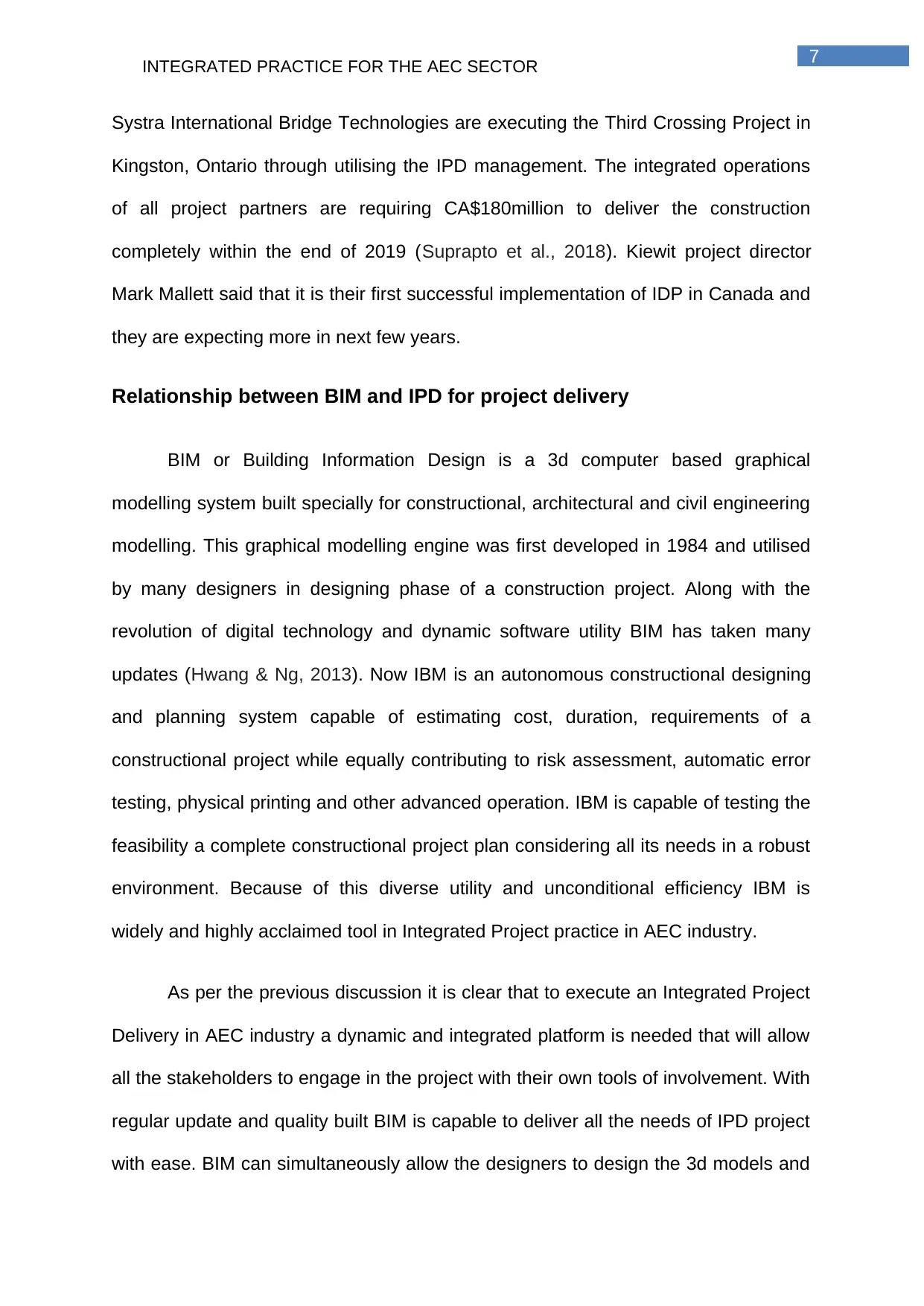
7
INTEGRATED PRACTICE FOR THE AEC SECTOR
Systra International Bridge Technologies are executing the Third Crossing Project in
Kingston, Ontario through utilising the IPD management. The integrated operations
of all project partners are requiring CA$180million to deliver the construction
completely within the end of 2019 (Suprapto et al., 2018). Kiewit project director
Mark Mallett said that it is their first successful implementation of IDP in Canada and
they are expecting more in next few years.
Relationship between BIM and IPD for project delivery
BIM or Building Information Design is a 3d computer based graphical
modelling system built specially for constructional, architectural and civil engineering
modelling. This graphical modelling engine was first developed in 1984 and utilised
by many designers in designing phase of a construction project. Along with the
revolution of digital technology and dynamic software utility BIM has taken many
updates (Hwang & Ng, 2013). Now IBM is an autonomous constructional designing
and planning system capable of estimating cost, duration, requirements of a
constructional project while equally contributing to risk assessment, automatic error
testing, physical printing and other advanced operation. IBM is capable of testing the
feasibility a complete constructional project plan considering all its needs in a robust
environment. Because of this diverse utility and unconditional efficiency IBM is
widely and highly acclaimed tool in Integrated Project practice in AEC industry.
As per the previous discussion it is clear that to execute an Integrated Project
Delivery in AEC industry a dynamic and integrated platform is needed that will allow
all the stakeholders to engage in the project with their own tools of involvement. With
regular update and quality built BIM is capable to deliver all the needs of IPD project
with ease. BIM can simultaneously allow the designers to design the 3d models and
INTEGRATED PRACTICE FOR THE AEC SECTOR
Systra International Bridge Technologies are executing the Third Crossing Project in
Kingston, Ontario through utilising the IPD management. The integrated operations
of all project partners are requiring CA$180million to deliver the construction
completely within the end of 2019 (Suprapto et al., 2018). Kiewit project director
Mark Mallett said that it is their first successful implementation of IDP in Canada and
they are expecting more in next few years.
Relationship between BIM and IPD for project delivery
BIM or Building Information Design is a 3d computer based graphical
modelling system built specially for constructional, architectural and civil engineering
modelling. This graphical modelling engine was first developed in 1984 and utilised
by many designers in designing phase of a construction project. Along with the
revolution of digital technology and dynamic software utility BIM has taken many
updates (Hwang & Ng, 2013). Now IBM is an autonomous constructional designing
and planning system capable of estimating cost, duration, requirements of a
constructional project while equally contributing to risk assessment, automatic error
testing, physical printing and other advanced operation. IBM is capable of testing the
feasibility a complete constructional project plan considering all its needs in a robust
environment. Because of this diverse utility and unconditional efficiency IBM is
widely and highly acclaimed tool in Integrated Project practice in AEC industry.
As per the previous discussion it is clear that to execute an Integrated Project
Delivery in AEC industry a dynamic and integrated platform is needed that will allow
all the stakeholders to engage in the project with their own tools of involvement. With
regular update and quality built BIM is capable to deliver all the needs of IPD project
with ease. BIM can simultaneously allow the designers to design the 3d models and
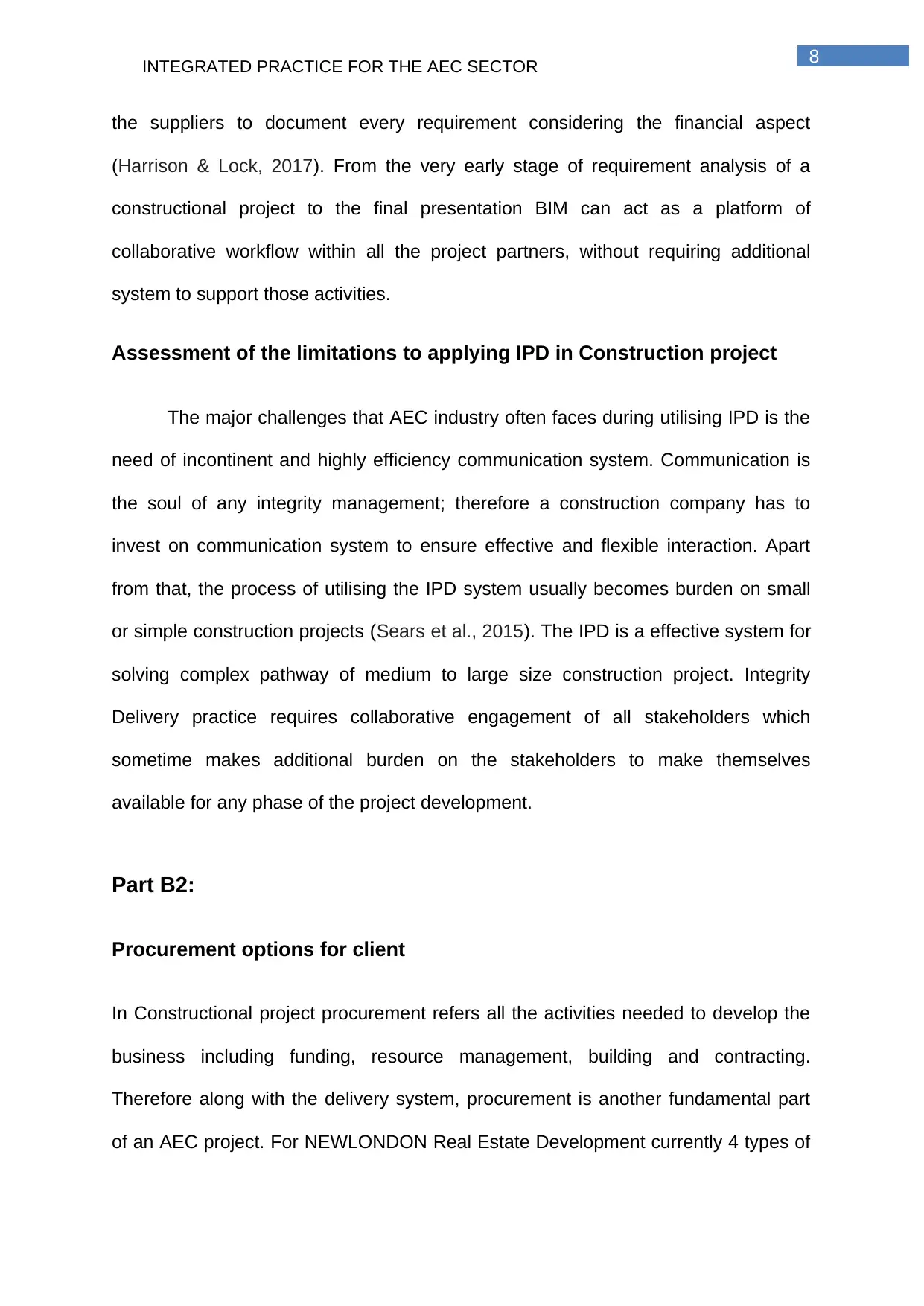
8
INTEGRATED PRACTICE FOR THE AEC SECTOR
the suppliers to document every requirement considering the financial aspect
(Harrison & Lock, 2017). From the very early stage of requirement analysis of a
constructional project to the final presentation BIM can act as a platform of
collaborative workflow within all the project partners, without requiring additional
system to support those activities.
Assessment of the limitations to applying IPD in Construction project
The major challenges that AEC industry often faces during utilising IPD is the
need of incontinent and highly efficiency communication system. Communication is
the soul of any integrity management; therefore a construction company has to
invest on communication system to ensure effective and flexible interaction. Apart
from that, the process of utilising the IPD system usually becomes burden on small
or simple construction projects (Sears et al., 2015). The IPD is a effective system for
solving complex pathway of medium to large size construction project. Integrity
Delivery practice requires collaborative engagement of all stakeholders which
sometime makes additional burden on the stakeholders to make themselves
available for any phase of the project development.
Part B2:
Procurement options for client
In Constructional project procurement refers all the activities needed to develop the
business including funding, resource management, building and contracting.
Therefore along with the delivery system, procurement is another fundamental part
of an AEC project. For NEWLONDON Real Estate Development currently 4 types of
INTEGRATED PRACTICE FOR THE AEC SECTOR
the suppliers to document every requirement considering the financial aspect
(Harrison & Lock, 2017). From the very early stage of requirement analysis of a
constructional project to the final presentation BIM can act as a platform of
collaborative workflow within all the project partners, without requiring additional
system to support those activities.
Assessment of the limitations to applying IPD in Construction project
The major challenges that AEC industry often faces during utilising IPD is the
need of incontinent and highly efficiency communication system. Communication is
the soul of any integrity management; therefore a construction company has to
invest on communication system to ensure effective and flexible interaction. Apart
from that, the process of utilising the IPD system usually becomes burden on small
or simple construction projects (Sears et al., 2015). The IPD is a effective system for
solving complex pathway of medium to large size construction project. Integrity
Delivery practice requires collaborative engagement of all stakeholders which
sometime makes additional burden on the stakeholders to make themselves
available for any phase of the project development.
Part B2:
Procurement options for client
In Constructional project procurement refers all the activities needed to develop the
business including funding, resource management, building and contracting.
Therefore along with the delivery system, procurement is another fundamental part
of an AEC project. For NEWLONDON Real Estate Development currently 4 types of
⊘ This is a preview!⊘
Do you want full access?
Subscribe today to unlock all pages.

Trusted by 1+ million students worldwide

9
INTEGRATED PRACTICE FOR THE AEC SECTOR
procurement process are available namely Traditional method, Design and build
method, Management contracting method and Joint venture or partnering method.
In Traditional procurement method the contractor will take the responsibility of only
the building where the design and management work will be carried out by the
engineer. In this process NEWLONDON Real Estate Development can have
complete control over finance and operation. On the other hand, in design and build
the contractor will play the major role of design and build while limiting the role of
consultant only to the management of the contract. Management contracting
procurement will allow the contractors to play a major role in decision making and
management as a part of the client-consultant team (Doloi et el., 2012). In this
procurement method NEWLONDON Real Estate Development has to choose a
particular package to develop the project from the set of packages offered by the
contractors. The most suitable procurement method that can be used in IPD
management is joint venture. In this procurement process NEWLONDON Real
Estate Development has to collaborate with all the stakeholders with financial and
operational responsibilities.
Strength and Weakness of methods
Procurement
method
Strength Weakness
Traditional
method
Finance and other operations will
be directly controlled by
NEWLONDON Real Estate
Development
Client can obtain best and lowest
price through competitive
tendering.
The risks can be solved in the
Responsibility of the contractor
is limited
Low tangibility in small projects
Consultant and contractor will
not have any contractual
relationship that requires
constant interference of client.
INTEGRATED PRACTICE FOR THE AEC SECTOR
procurement process are available namely Traditional method, Design and build
method, Management contracting method and Joint venture or partnering method.
In Traditional procurement method the contractor will take the responsibility of only
the building where the design and management work will be carried out by the
engineer. In this process NEWLONDON Real Estate Development can have
complete control over finance and operation. On the other hand, in design and build
the contractor will play the major role of design and build while limiting the role of
consultant only to the management of the contract. Management contracting
procurement will allow the contractors to play a major role in decision making and
management as a part of the client-consultant team (Doloi et el., 2012). In this
procurement method NEWLONDON Real Estate Development has to choose a
particular package to develop the project from the set of packages offered by the
contractors. The most suitable procurement method that can be used in IPD
management is joint venture. In this procurement process NEWLONDON Real
Estate Development has to collaborate with all the stakeholders with financial and
operational responsibilities.
Strength and Weakness of methods
Procurement
method
Strength Weakness
Traditional
method
Finance and other operations will
be directly controlled by
NEWLONDON Real Estate
Development
Client can obtain best and lowest
price through competitive
tendering.
The risks can be solved in the
Responsibility of the contractor
is limited
Low tangibility in small projects
Consultant and contractor will
not have any contractual
relationship that requires
constant interference of client.
Paraphrase This Document
Need a fresh take? Get an instant paraphrase of this document with our AI Paraphraser
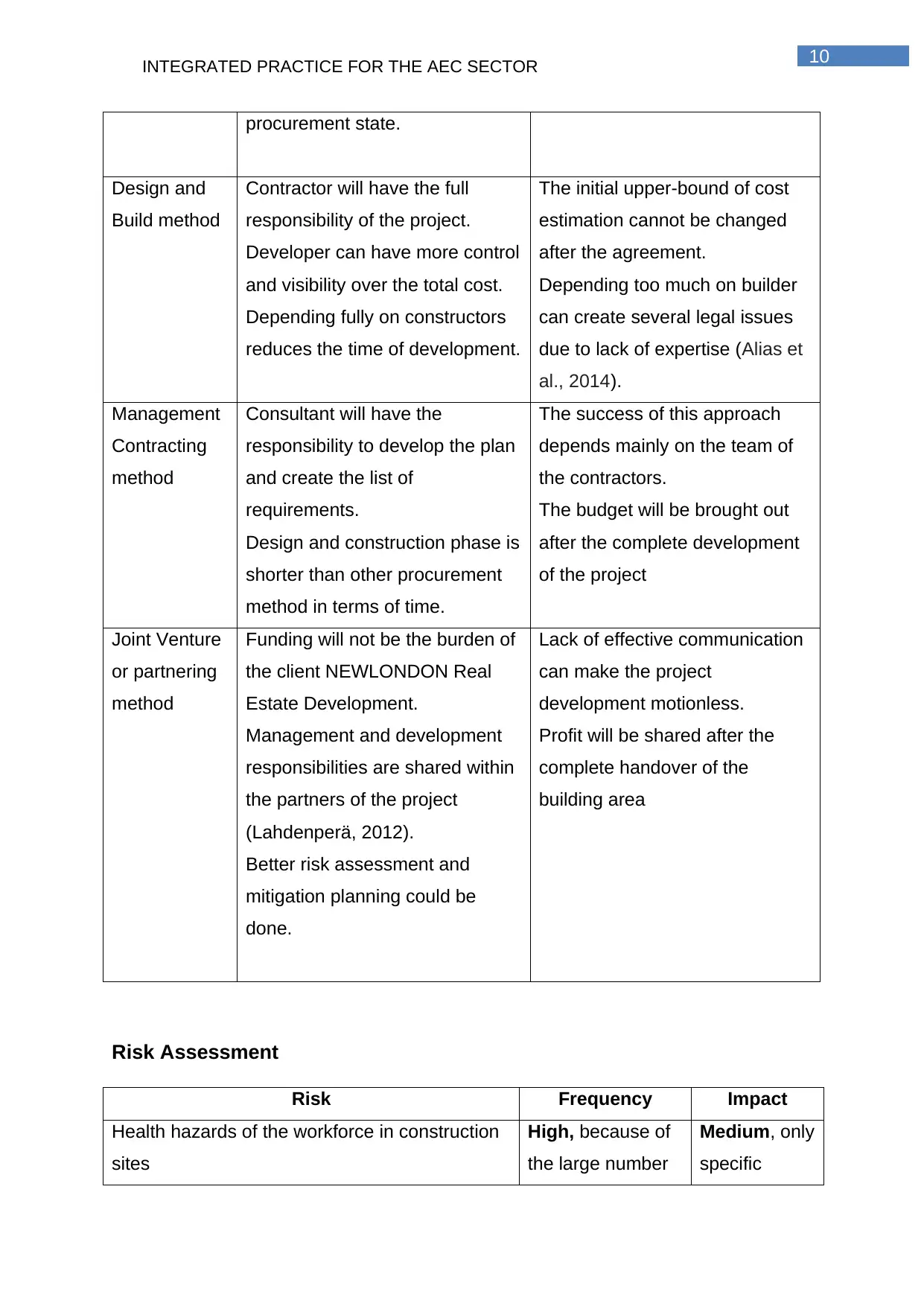
10
INTEGRATED PRACTICE FOR THE AEC SECTOR
procurement state.
Design and
Build method
Contractor will have the full
responsibility of the project.
Developer can have more control
and visibility over the total cost.
Depending fully on constructors
reduces the time of development.
The initial upper-bound of cost
estimation cannot be changed
after the agreement.
Depending too much on builder
can create several legal issues
due to lack of expertise (Alias et
al., 2014).
Management
Contracting
method
Consultant will have the
responsibility to develop the plan
and create the list of
requirements.
Design and construction phase is
shorter than other procurement
method in terms of time.
The success of this approach
depends mainly on the team of
the contractors.
The budget will be brought out
after the complete development
of the project
Joint Venture
or partnering
method
Funding will not be the burden of
the client NEWLONDON Real
Estate Development.
Management and development
responsibilities are shared within
the partners of the project
(Lahdenperä, 2012).
Better risk assessment and
mitigation planning could be
done.
Lack of effective communication
can make the project
development motionless.
Profit will be shared after the
complete handover of the
building area
Risk Assessment
Risk Frequency Impact
Health hazards of the workforce in construction
sites
High, because of
the large number
Medium, only
specific
INTEGRATED PRACTICE FOR THE AEC SECTOR
procurement state.
Design and
Build method
Contractor will have the full
responsibility of the project.
Developer can have more control
and visibility over the total cost.
Depending fully on constructors
reduces the time of development.
The initial upper-bound of cost
estimation cannot be changed
after the agreement.
Depending too much on builder
can create several legal issues
due to lack of expertise (Alias et
al., 2014).
Management
Contracting
method
Consultant will have the
responsibility to develop the plan
and create the list of
requirements.
Design and construction phase is
shorter than other procurement
method in terms of time.
The success of this approach
depends mainly on the team of
the contractors.
The budget will be brought out
after the complete development
of the project
Joint Venture
or partnering
method
Funding will not be the burden of
the client NEWLONDON Real
Estate Development.
Management and development
responsibilities are shared within
the partners of the project
(Lahdenperä, 2012).
Better risk assessment and
mitigation planning could be
done.
Lack of effective communication
can make the project
development motionless.
Profit will be shared after the
complete handover of the
building area
Risk Assessment
Risk Frequency Impact
Health hazards of the workforce in construction
sites
High, because of
the large number
Medium, only
specific
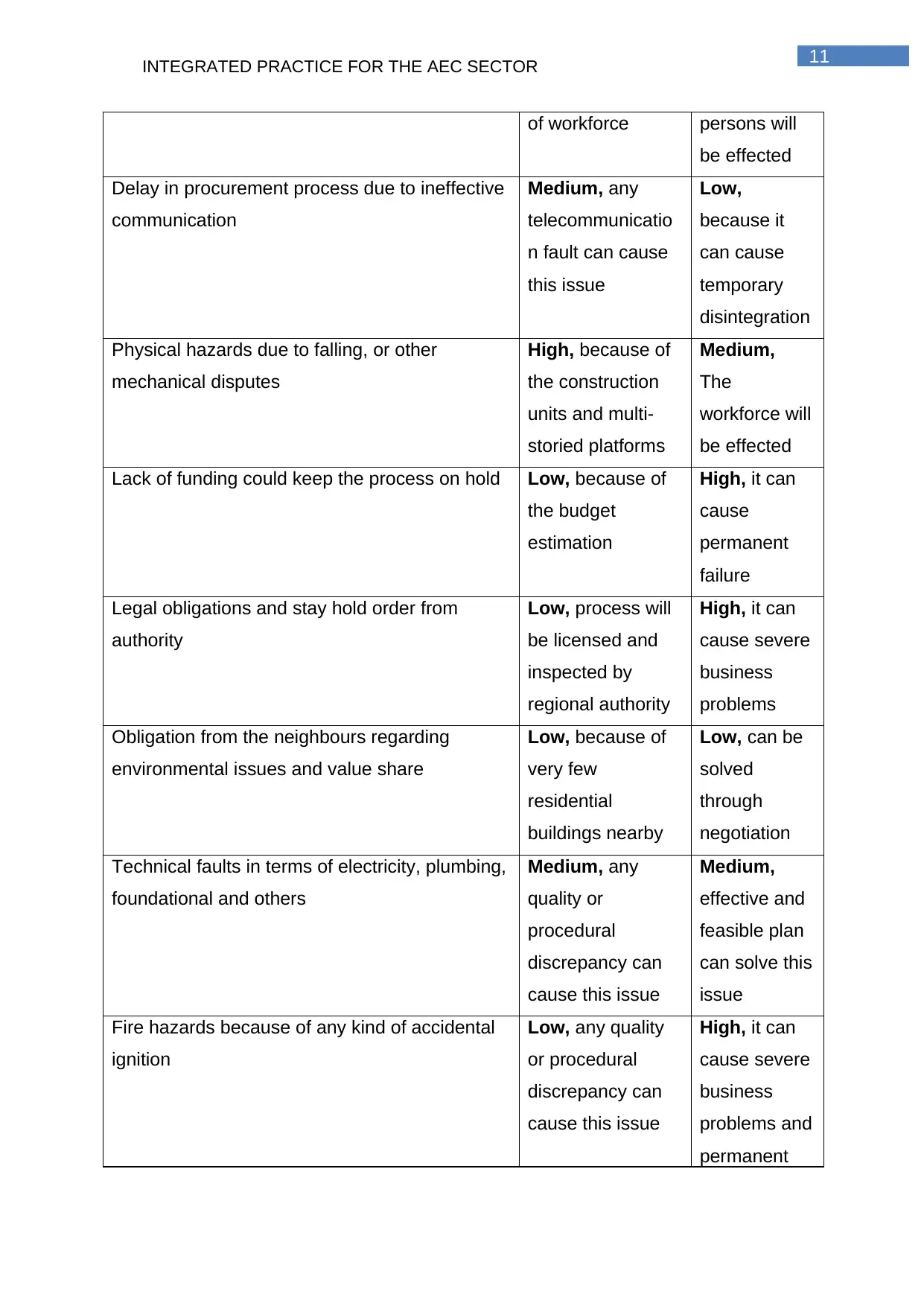
11
INTEGRATED PRACTICE FOR THE AEC SECTOR
of workforce persons will
be effected
Delay in procurement process due to ineffective
communication
Medium, any
telecommunicatio
n fault can cause
this issue
Low,
because it
can cause
temporary
disintegration
Physical hazards due to falling, or other
mechanical disputes
High, because of
the construction
units and multi-
storied platforms
Medium,
The
workforce will
be effected
Lack of funding could keep the process on hold Low, because of
the budget
estimation
High, it can
cause
permanent
failure
Legal obligations and stay hold order from
authority
Low, process will
be licensed and
inspected by
regional authority
High, it can
cause severe
business
problems
Obligation from the neighbours regarding
environmental issues and value share
Low, because of
very few
residential
buildings nearby
Low, can be
solved
through
negotiation
Technical faults in terms of electricity, plumbing,
foundational and others
Medium, any
quality or
procedural
discrepancy can
cause this issue
Medium,
effective and
feasible plan
can solve this
issue
Fire hazards because of any kind of accidental
ignition
Low, any quality
or procedural
discrepancy can
cause this issue
High, it can
cause severe
business
problems and
permanent
INTEGRATED PRACTICE FOR THE AEC SECTOR
of workforce persons will
be effected
Delay in procurement process due to ineffective
communication
Medium, any
telecommunicatio
n fault can cause
this issue
Low,
because it
can cause
temporary
disintegration
Physical hazards due to falling, or other
mechanical disputes
High, because of
the construction
units and multi-
storied platforms
Medium,
The
workforce will
be effected
Lack of funding could keep the process on hold Low, because of
the budget
estimation
High, it can
cause
permanent
failure
Legal obligations and stay hold order from
authority
Low, process will
be licensed and
inspected by
regional authority
High, it can
cause severe
business
problems
Obligation from the neighbours regarding
environmental issues and value share
Low, because of
very few
residential
buildings nearby
Low, can be
solved
through
negotiation
Technical faults in terms of electricity, plumbing,
foundational and others
Medium, any
quality or
procedural
discrepancy can
cause this issue
Medium,
effective and
feasible plan
can solve this
issue
Fire hazards because of any kind of accidental
ignition
Low, any quality
or procedural
discrepancy can
cause this issue
High, it can
cause severe
business
problems and
permanent
⊘ This is a preview!⊘
Do you want full access?
Subscribe today to unlock all pages.

Trusted by 1+ million students worldwide
1 out of 23
Related Documents
Your All-in-One AI-Powered Toolkit for Academic Success.
+13062052269
info@desklib.com
Available 24*7 on WhatsApp / Email
![[object Object]](/_next/static/media/star-bottom.7253800d.svg)
Unlock your academic potential
Copyright © 2020–2025 A2Z Services. All Rights Reserved. Developed and managed by ZUCOL.





